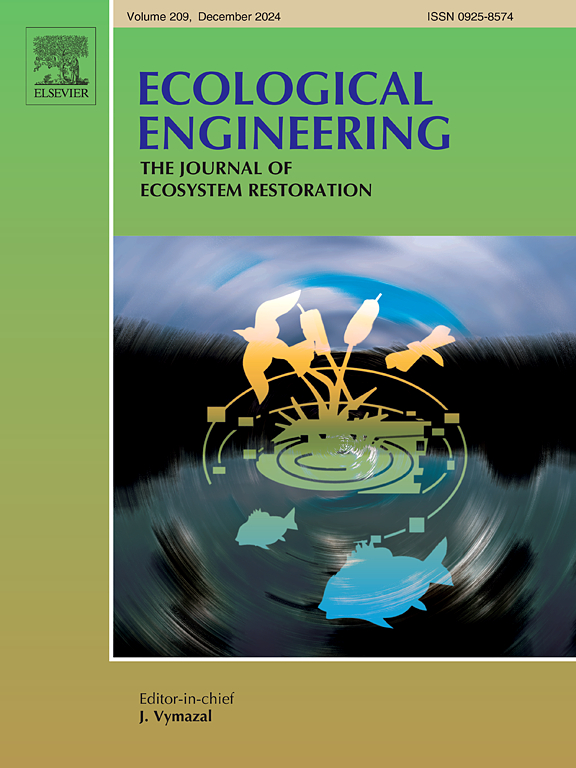Design and performance of an in-stream woodchip denitrifying bioreactor treating agricultural drainage 2. Co-benefits and greenhouse gas emissions
IF 4.1
2区 环境科学与生态学
Q1 ECOLOGY
引用次数: 0
Abstract
Woodchip denitrifying bioreactors (WDBs) are an established edge-of-field practice for mitigating nitrogen losses in agricultural watersheds. WDBs also have potential to remove other aquatic contaminants associated with farming. We examined the efficacy of a large (450 m3) in-stream WDB at removing phosphorus (P) and microbial pathogens, present in farm drainage water, as secondary treatment co-benefits. We provide the first examination of Campylobacter removal effected by a WDB. Greenhouse gas emissions were also evaluated as a pollution-swapping phenomenon and related to the physio-chemical state of the bioreactor. Occasionally, small quantities of P were exported from the WDB, but overall it acted as a net sink for P with approximately 17.5 kg of total P and 8.1 kg dissolved reactive P removed over the 25-month study period. The WDB showed moderate capacity for removal of microbial contaminants. The median reduction of Escherichia coli was 0.98-log, which was less than the median reduction of 1.23-log determined for Campylobacter. The in-stream WDB acted as a source of greenhouse gases and production was related to hydraulic retention times and temperature. Production and export of methane was distinctly seasonal and showed a strong positive correlation with temperature, whereas nitrous oxide emission was influenced by cooler temperatures. On average, 4 % of the nitrate-N denitrified by the bioreactor was exported as nitrous oxide. Our results indicate that methane export could be increasing as the hydraulic function of the WDB declines.
木屑反硝化生物反应器处理农业废水的设计与性能共同利益和温室气体排放
木片反硝化生物反应器(wdb)是缓解农业流域氮损失的一种成熟的前沿实践。wdb还具有去除与农业有关的其他水生污染物的潜力。我们研究了大型(450立方米)的流内WDB去除农场排水中存在的磷(P)和微生物病原体的功效,作为二级处理的辅助效益。我们提供了弯曲杆菌去除影响的WDB的第一次检查。温室气体排放也被评价为一种污染交换现象,并与生物反应器的理化状态有关。偶尔,少量磷从WDB输出,但总体而言,它作为磷的净汇,在25个月的研究期间,去除了约17.5 kg的总磷和8.1 kg的溶解活性磷。WDB对微生物污染物的去除能力中等。大肠杆菌的中位减量为0.98 log,低于弯曲杆菌的中位减量1.23 log。流内WDB是温室气体的来源,其产量与水力滞留时间和温度有关。甲烷的生产和出口具有明显的季节性,并与温度呈强烈的正相关,而氧化亚氮的排放则受到较低温度的影响。通过生物反应器反硝化的硝酸氮平均有4%以氧化亚氮的形式输出。研究结果表明,随着流域水力功能的减弱,甲烷出口量可能会增加。
本文章由计算机程序翻译,如有差异,请以英文原文为准。
求助全文
约1分钟内获得全文
求助全文
来源期刊

Ecological Engineering
环境科学-工程:环境
CiteScore
8.00
自引率
5.30%
发文量
293
审稿时长
57 days
期刊介绍:
Ecological engineering has been defined as the design of ecosystems for the mutual benefit of humans and nature. The journal is meant for ecologists who, because of their research interests or occupation, are involved in designing, monitoring, or restoring ecosystems, and can serve as a bridge between ecologists and engineers.
Specific topics covered in the journal include: habitat reconstruction; ecotechnology; synthetic ecology; bioengineering; restoration ecology; ecology conservation; ecosystem rehabilitation; stream and river restoration; reclamation ecology; non-renewable resource conservation. Descriptions of specific applications of ecological engineering are acceptable only when situated within context of adding novelty to current research and emphasizing ecosystem restoration. We do not accept purely descriptive reports on ecosystem structures (such as vegetation surveys), purely physical assessment of materials that can be used for ecological restoration, small-model studies carried out in the laboratory or greenhouse with artificial (waste)water or crop studies, or case studies on conventional wastewater treatment and eutrophication that do not offer an ecosystem restoration approach within the paper.
 求助内容:
求助内容: 应助结果提醒方式:
应助结果提醒方式:


